No products in the cart.
NEWS
Conquering Common Tomato Diseases: An Expert Guide to Identification & Control
Growing juicy, ripe tomatoes is one of the most rewarding aspects of gardening, but nothing dampens that excitement faster than spotting unwelcome signs of disease on your beloved plants. From wilting leaves to spotted fruit, tomato diseases can significantly impact your harvest, sometimes even leading to the loss of the entire plant. As agricultural specialists dedicated to nurturing healthy growth, we understand the challenges gardeners face. Recognizing whether a problem is caused by an infectious pathogen or an environmental factor is the first crucial step in protecting your crop. This guide will walk you through identifying common tomato diseases and implementing effective control strategies to keep your tomato plants thriving.
Understanding the different types of diseases is key. Tomato plants can suffer from infectious diseases caused by microscopic organisms like fungi, bacteria, viruses, or nematodes. They can also face non-infectious issues stemming from environmental stressors, nutritional imbalances, or physical damage. Accurate identification is paramount because the treatment for a fungal issue differs greatly from that for a viral or environmental one.
Identifying Common Tomato Diseases
Tomato plants are susceptible to a range of problems throughout their growth cycle. Being able to spot the early symptoms is vital for timely intervention. Let’s explore some of the most frequently encountered diseases and how to differentiate them.
Fungal Diseases Affecting Tomato Plants
Fungi are common culprits behind many leaf spots, wilts, and blights. They often thrive in specific environmental conditions, particularly those involving moisture and temperature.
Fusarium Wilt
Fusarium wilt is a classic fungal disease that attacks the plant’s vascular system, blocking water uptake. The first signs often appear on the lower leaves, which turn yellow on one side of the leaf midrib or stem and then wilt and drop. This yellowing and wilting typically progresses upwards, eventually killing the entire plant as its ability to photosynthesize is destroyed.
This persistent fungus can survive in the soil for years and can also be transmitted through infected seeds. Warm soil temperatures (around 80-90°F or 27-32°C), sandy soil, and movement of soil or plant debris via wind, water, or garden tools facilitate its spread.
Managing Fusarium wilt primarily relies on prevention. Planting disease-resistant varieties and practicing crop rotation (avoiding planting tomatoes or related plants in the same spot for several years) are essential preventive measures. Once a plant is infected, there is no cure. Infected plants should be carefully removed, bagged, and disposed of away from the garden area – never compost diseased material.
Verticillium Wilt
Similar to Fusarium wilt, Verticillium wilt also causes wilting and yellowing of leaves, often starting on one side of the leaf or plant. However, Verticillium wilt may affect both sides of the plant more symmetrically than Fusarium. Many modern tomato hybrid varieties offer resistance to both Fusarium and Verticillium wilts, making variety selection a critical control method.
Anthracnose
Anthracnose is a common fungal disease that primarily targets the ripening fruit. It appears as small, circular, sunken spots on the fruit’s surface. These spots can enlarge and merge, often developing concentric rings and dark centers dotted with fungal spores. These lesions provide entry points for other rot-causing organisms, further damaging the fruit.
Practicing good sanitation, such as removing infected fruit promptly, and using mulch to prevent soil splashing onto the fruit can help manage Anthracnose.
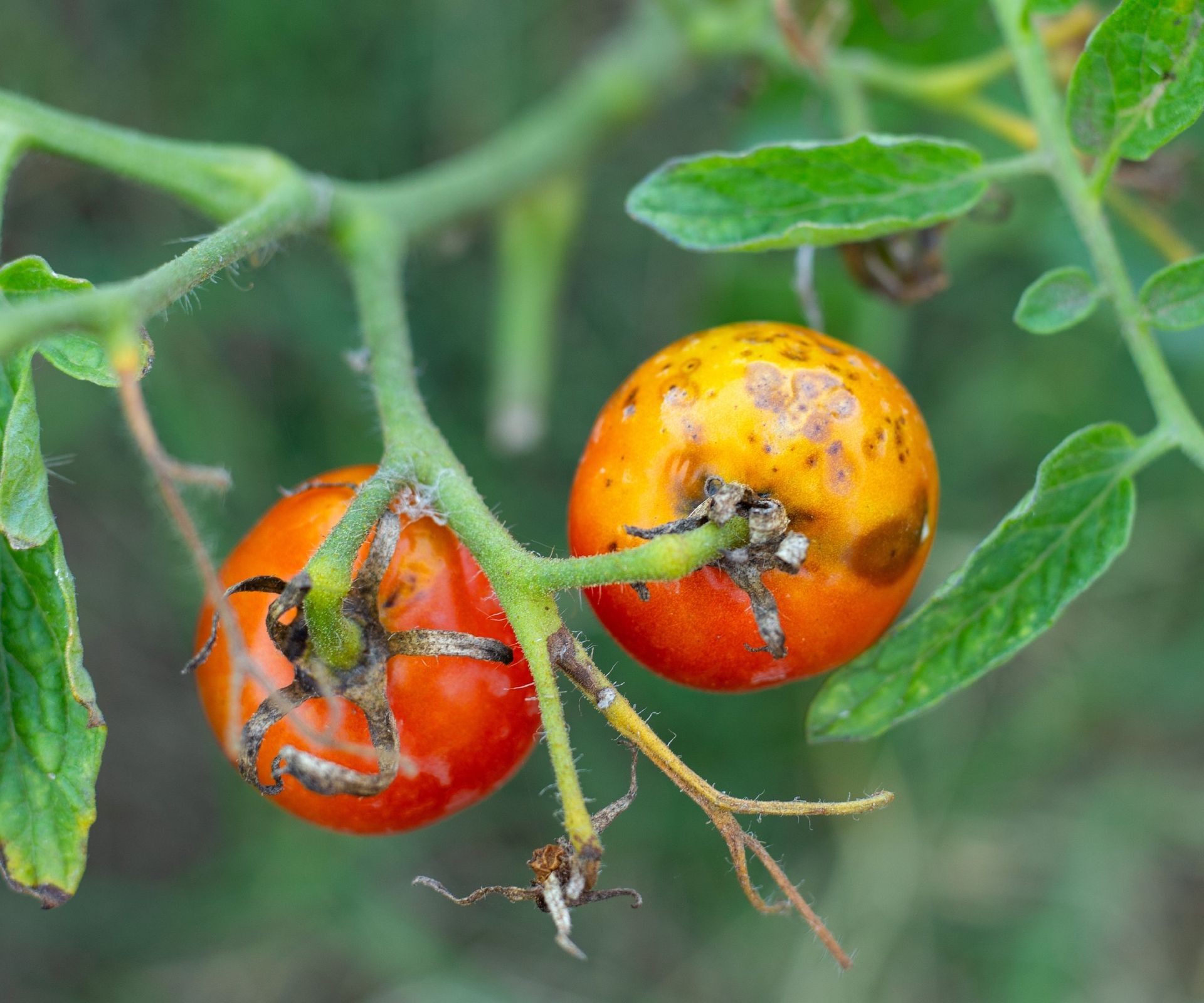 Tomatoes infected with late blight
Tomatoes infected with late blight
Blights
Blights are notorious for their rapid and devastating effects.
- Southern Blight: Caused by the soil-borne fungus Sclerotium rolfsii, Southern blight has a wide host range and can quickly kill tomato plants. It often starts with water-soaked lesions on the stem near the soil line, which rapidly expand and girdle the stem. A characteristic sign is the presence of white, thread-like fungal growth and small, brown, mustard-seed-like structures (sclerotia) on the lesions and surrounding soil. High humidity, warm temperatures (85-95°F or 29-35°C), and moist soil favor this disease. Controlling Southern blight is challenging due to the fungus’s survival structures in the soil. Crop rotation helps, and in severe cases, certain fungicides may offer some suppression.
- Early Blight: Often appearing earlier in the season, Early blight causes dark spots with concentric rings (resembling a target) on the lower leaves. If it progresses, it can affect stems and fruit, causing dark, leathery spots near the stem end.
- Late Blight: Infamous for causing the Irish potato famine, Late blight is a highly destructive disease that can affect tomatoes, especially in cool, wet weather with heavy dew or rain. Symptoms include dark, water-soaked lesions on leaves that quickly enlarge, often with white fungal growth on the underside in humid conditions. Fruit develops large, brown, firm rot. This disease spreads rapidly and can wipe out a crop quickly.
For any fungal disease, diligent sanitation is crucial. Removing and destroying infected plant debris throughout the season and after harvest helps reduce the amount of fungal inoculum. Keeping the area weed-free improves air circulation and reduces humidity around plants. Sanitize garden tools after working with infected plants. A strict 3-4 year crop rotation, avoiding planting tomatoes and other nightshades in the same spot, is highly recommended.
Molds and Mildews
Among the common tomato diseases, molds and mildews are often visually striking. Powdery mildew is a fungal disease that appears as white, powdery patches on the surface of leaves and stems. It’s often found where plants are crowded, leading to poor air circulation and higher humidity within the canopy. While it might not immediately kill the plant, severe infections can weaken it, reduce photosynthesis, and decrease yield. Improving air circulation by proper spacing and pruning, and ensuring adequate sunlight penetration, can help prevent mildew.
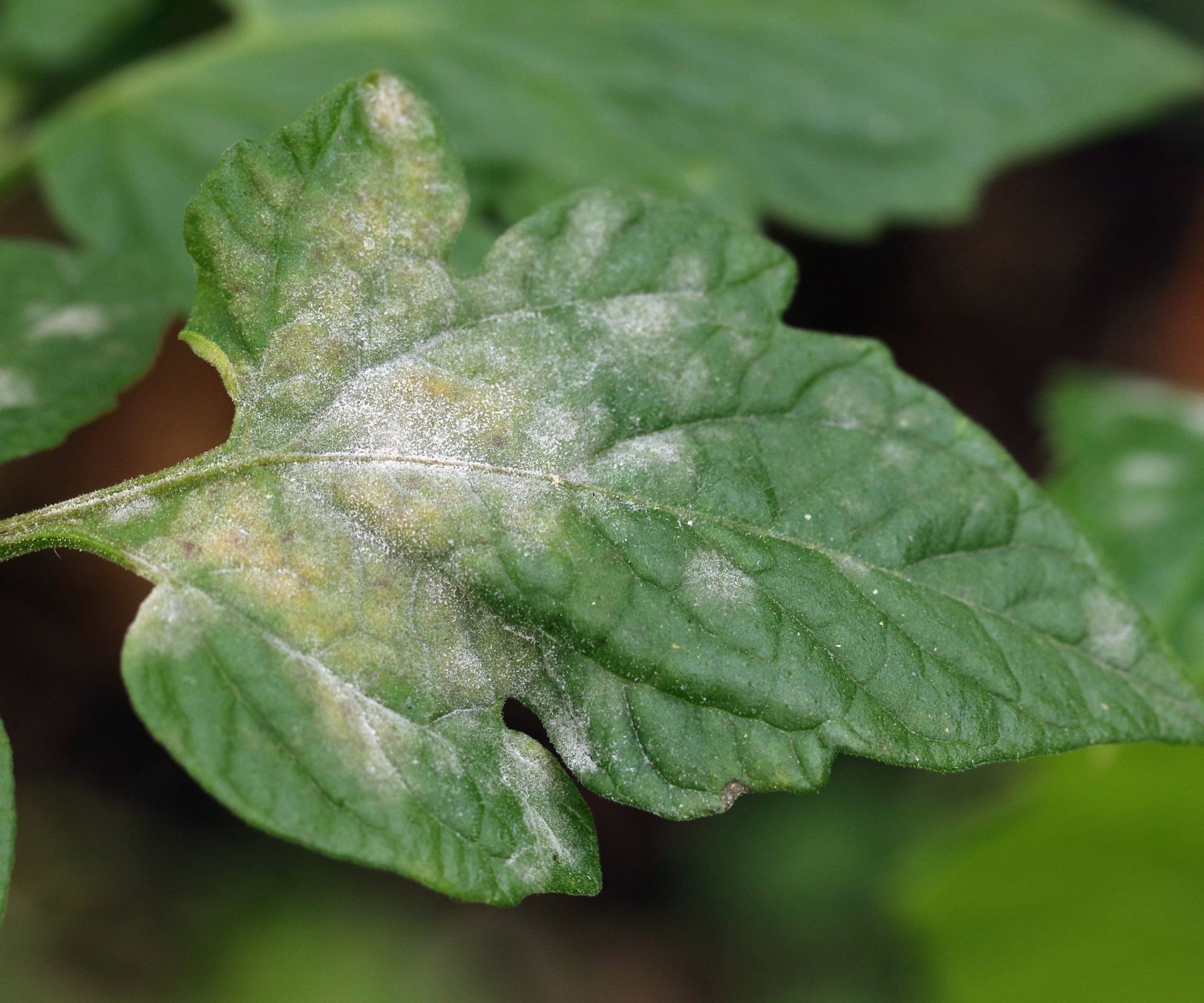 A tomato leaf infected with powdery mildew
A tomato leaf infected with powdery mildew
Bacterial Diseases of Tomato Plants
Bacterial diseases are caused by microscopic single-celled organisms. They can multiply rapidly and are often spread by water splash, wind, tools, or even people and animals. They commonly enter plants through natural openings or wounds.
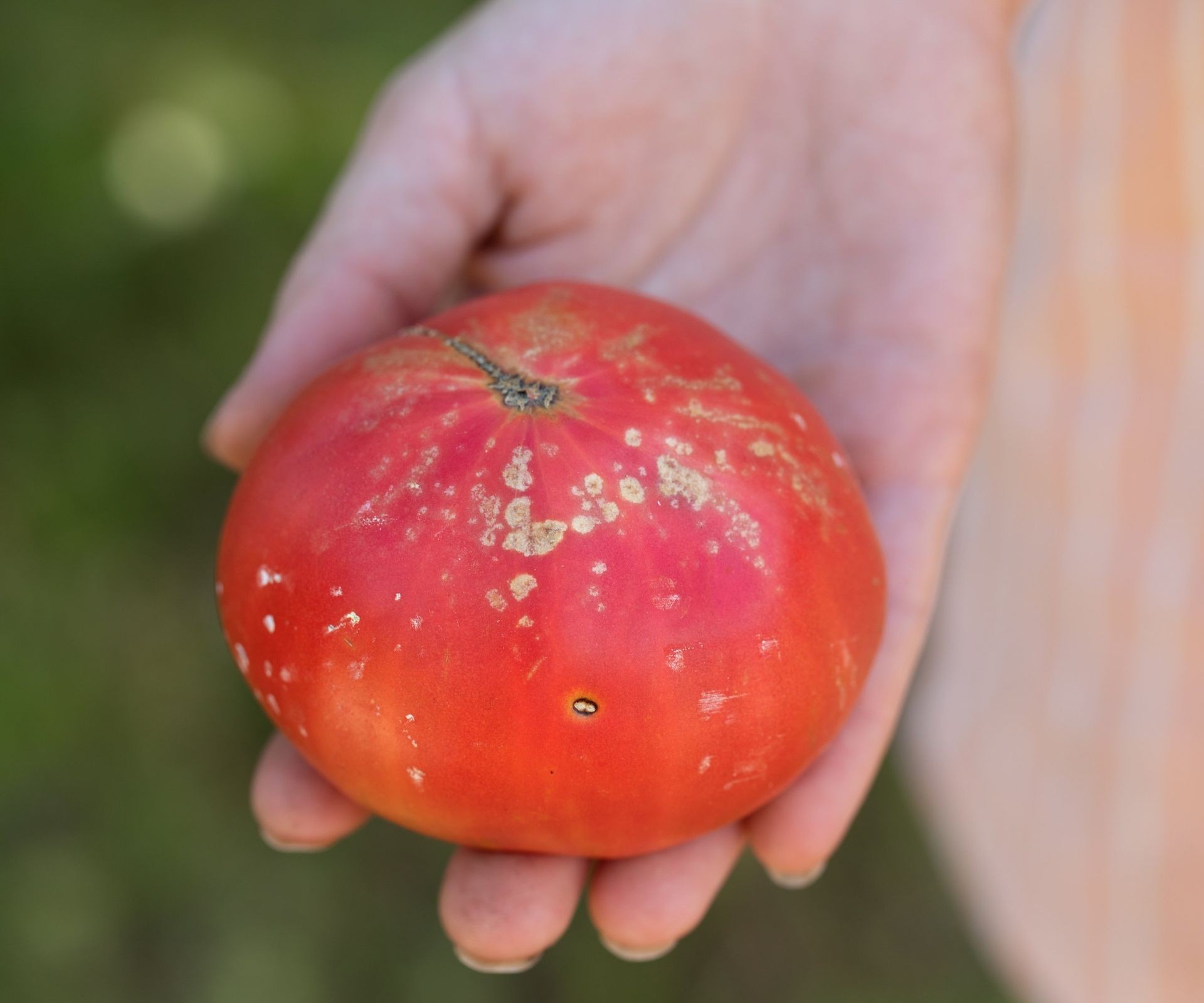 A hand holding a tomato infected with bacterial canker
A hand holding a tomato infected with bacterial canker
Bacterial Spot and Speck
These two bacterial diseases cause leaf spots that can look very similar.
- Bacterial Spot: Causes small, dark brown, greasy-looking spots on leaves, stems, and green fruit at any growth stage. On leaves, spots may be surrounded by a yellow halo, and severe spotting can lead to leaf yellowing and drop, progressing from the bottom up. On green fruit, spots are raised and scabby; on ripe fruit, they can become sunken. Favored by wet, warm conditions (75-85°F or 24-29°C).
 A hand holding a tomato leaf infected with septoria leaf spot
A hand holding a tomato leaf infected with septoria leaf spot - Bacterial Speck: Causes very small, dark brown to black spots, usually with a distinct yellow halo, primarily on leaves and green fruit. It is favored by wet conditions but cooler temperatures (55-77°F or 13-25°C).
Control methods for both are similar: start with certified disease-free seed and transplants. Remove all plant debris after harvest. Practice crop rotation. Use drip irrigation instead of overhead watering to keep foliage dry. Weekly applications of a copper-based spray can help suppress the spread, especially when conditions are favorable for the disease.
Bacterial Canker and Wilt
These are serious bacterial diseases that can cause significant plant damage.
- Bacterial Canker: This disease can produce a variety of symptoms, making diagnosis tricky. Symptoms can include one-sided wilting and leaf death, brown streaks inside the stem, and characteristic “bird’s-eye” spots (small, pale spots with a dark center) on the fruit.
- Bacterial Wilt: This disease causes rapid, often sudden wilting of the entire plant, even when soil moisture is adequate. If you cut the stem of a wilting plant near the soil line, squeezing it may reveal a slimy, milky ooze, which is a tell-tale sign of bacterial wilt.
Both diseases can be transmitted through contaminated seed or transplants and can survive on plant debris or related weeds. They are easily spread by splashing water, rain, and human activity or tools. There are no effective bactericides once a plant is infected, and no cure. The most effective control is prevention: using certified clean seed and transplants, practicing crop rotation, and immediately removing and destroying infected plants at the first sign of symptoms to prevent spread.
Viral Diseases Affecting Tomato Plants
Viral diseases are caused by tiny virus particles that infect plant cells. They are often transmitted by insect vectors (like aphids or thrips) or mechanically through handling plants. Once a plant is infected with a virus, there is generally no cure.
Alfalfa Mosaic Virus
Alfalfa mosaic virus has a wide host range. In tomatoes, it is often transmitted by aphids or through mechanical means. It’s more common when tomatoes are planted near infected alfalfa fields. Symptoms include a striking yellow mosaic or mottled pattern on new foliage, sometimes accompanied by stunting. In some cases, it can cause severe browning and cracking of the fruit. Preventing this disease involves controlling aphid populations, removing infected plants promptly, and avoiding planting tomatoes directly adjacent to alfalfa fields.
Curly Top Virus
Also known as beet curly top virus, this disease is transmitted by the beet leafhopper. While leafhoppers don’t typically feed on tomatoes, they can transmit the virus if they briefly visit the plant. Symptoms begin as upward curling and yellowing (pale green) of the upper leaves. As the disease progresses, all foliage may become twisted, stunted, and thickened with prominent purple veins on the undersides. Early infection can be lethal to young plants. Managing curly top focuses on deterring the leafhopper vector. Strategies include intercropping with non-host plants, varying planting patterns, using row covers early in the season, or planting in partially shaded areas. Insecticides are generally ineffective against the sporadic feeding of leafhoppers.
Tobacco Mosaic Virus
Tobacco mosaic virus (TMV) is less of a major threat today due to the availability of resistant varieties. It’s highly contagious and easily spread mechanically through contaminated hands, tools, or clothing, especially after handling tobacco products (which can carry the virus) or infected plants. Symptoms vary depending on the virus strain and tomato variety but often include mottling, curling, and distortion of leaves. Fruit may sometimes show mosaic patterns but is often unaffected. While there’s no cure, choosing resistant varieties is the primary control. Gardeners who use tobacco products should wash their hands thoroughly before handling tomato plants.
Tomato Spotted Wilt
Tomato spotted wilt is caused by a complex of viruses transmitted primarily by tiny insects called thrips. It is a significant disease in many regions, particularly affecting tomatoes and peppers. Symptoms are highly variable, making diagnosis difficult without testing, but can include stunting, bronzing or browning spots and rings on young leaves, stem streaking, and distorted or spotted fruit. Early infection can lead to major fruit loss.
Control is challenging and focuses on preventing thrip infestation. Using healthy, virus-free transplants is crucial. In greenhouses, using thrip-proof screens and inspecting incoming plants helps. In the field, managing weeds (which can host thrips and the virus) and removing infected plants promptly are important. Planting resistant varieties is the most effective long-term strategy, as insecticides are generally poor at preventing thrips from probing and transmitting the virus.
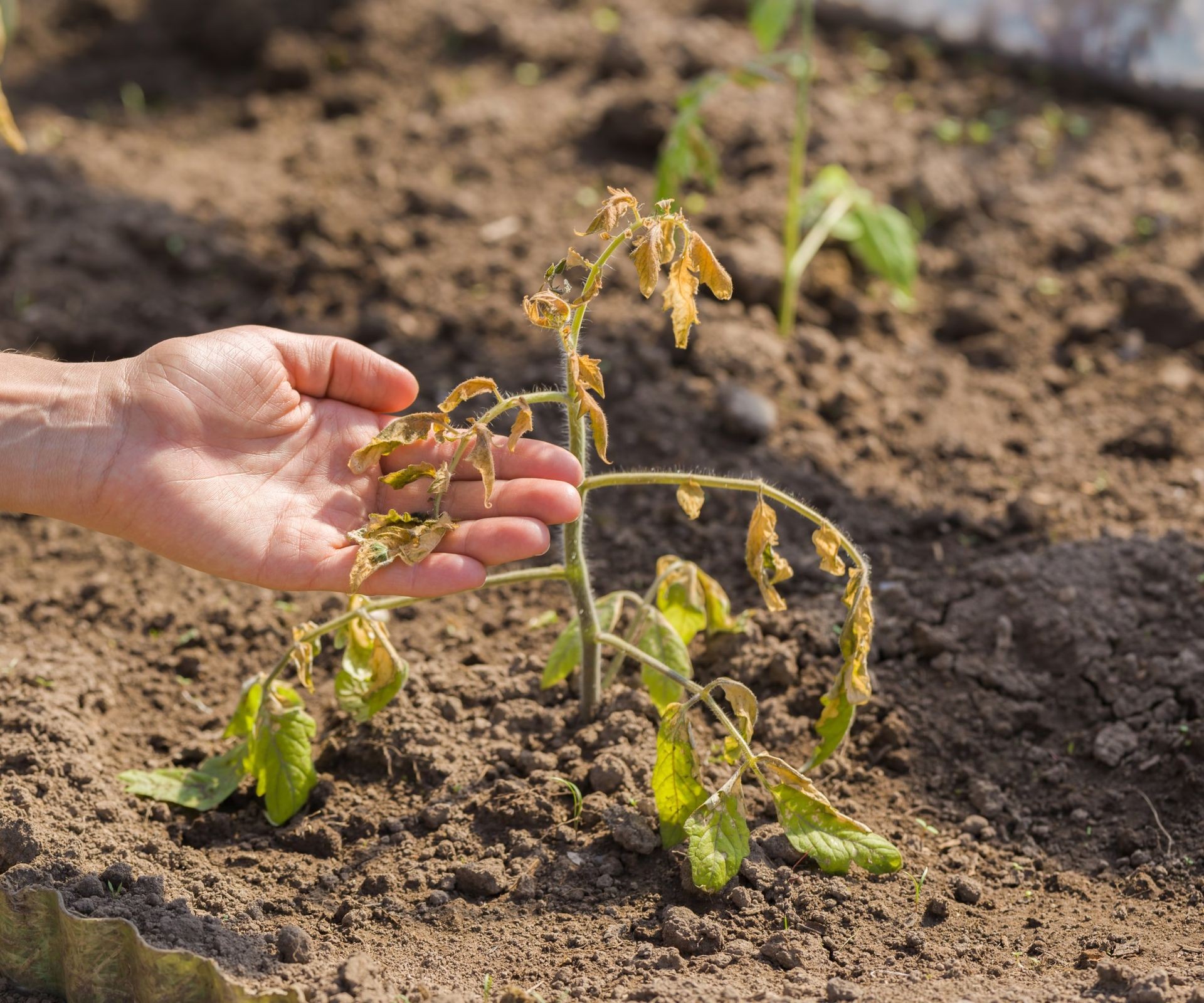 A hand holding the wilted leaves of a tomato seedling damaged by cold
A hand holding the wilted leaves of a tomato seedling damaged by cold
Environmental Stressors and Non-Infectious Issues
Not all tomato plant problems are caused by pathogens. Environmental conditions and cultural practices play a huge role in plant health and can cause symptoms that might be mistaken for disease.
- Temperature: Temperatures below 50°F (10°C) or consistently above 90°F (32°C) can cause blossom drop, poor pollination, and reduced fruit set.
- Watering Issues: Both too little and too much water cause stress. Underwatering leads to wilting and can contribute to issues like blossom end rot. Overwatering can suffocate roots, lead to root rot (a type of fungal disease often secondary to poor drainage), and cause leaves to yellow or wilt. Uneven watering is a primary cause of fruit cracking and blossom end rot (a physiological disorder causing a dark, sunken area on the blossom end of the fruit, linked to calcium uptake issues often exacerbated by inconsistent moisture).
- Nutrient Imbalances: Too much nitrogen promotes lush leafy growth at the expense of fruit and can make plants more susceptible to some diseases. Deficiencies in essential nutrients like calcium (leading to blossom end rot) or magnesium can cause leaf yellowing.
- Soil Health: Poor soil structure, compaction, or lack of organic matter negatively impacts root health and nutrient uptake, making plants more vulnerable. Saline soil can also damage roots and hinder water absorption.
- Sunscald: Intense sun can cause pale or yellow patches on fruit, especially on exposed shoulders.
- Catfacing: A physiological disorder causing distorted, scarred areas, often at the blossom end of the fruit. It’s linked to environmental factors during flower set, such as cold temperatures or fluctuations.
- Herbicide Damage: Drift from nearby herbicide applications can cause severe leaf distortion and damage.
- Frost Injury: Cold temperatures below freezing will cause plant tissues to turn dark and mushy.
Recognizing these non-infectious issues is crucial because they require adjusting your care practices rather than applying fungicides or bactericides.
Proactive Strategies for Healthy Tomato Plants
Successfully managing tomato diseases involves an integrated approach focusing on prevention and early intervention. Here are key strategies:
- Choose Resistant Varieties: Select tomato varieties labeled with resistance to common diseases in your area (e.g., marked with F, V, N, T for resistance to Fusarium, Verticillium, Nematodes, TMV).
- Start with Clean Materials: Use certified disease-free seed or purchase healthy, vigorous transplants from a reputable source.
- Practice Crop Rotation: Rotate your tomato crops (and other nightshade family plants like peppers, eggplants, potatoes) in a 3-4 year cycle to reduce soil-borne pathogens.
- Sanitation is Key: Clean garden tools regularly. Remove and destroy diseased plant material immediately – do not compost it. Clean up all plant debris at the end of the season. Control weeds, which can harbor pests and diseases.
- Proper Watering: Water consistently, preferably using drip irrigation or watering at the base of the plant to keep foliage dry, which reduces the spread of many fungal and bacterial diseases. Water deeply and less frequently rather than shallowly and often.
- Improve Soil Health: Build healthy soil rich in organic matter. Good drainage is essential.
- Ensure Good Air Circulation: Space plants appropriately and prune excess foliage to allow air to move freely through the canopy, reducing humidity.
- Monitor Regularly: Inspect your plants frequently for early signs of trouble. The sooner you spot a problem, the easier it is to manage.
Conclusion
Navigating the world of tomato diseases can feel daunting, but armed with knowledge about identification and proactive management techniques, you can significantly increase your chances of a successful, bountiful tomato harvest. From understanding the differences between fungal, bacterial, and viral threats to recognizing environmental stressors, each piece of the puzzle helps you respond effectively.
Prioritizing clean practices, selecting the right varieties, and nurturing healthy soil creates a strong foundation for resilient plants. While challenges may still arise, your ability to identify issues early and implement appropriate controls will make all the difference.
At Biogarden.asia, we are passionate about supporting growers like you in cultivating vibrant, healthy gardens. Explore our resources and range of products designed to enhance soil vitality, promote plant strength, and assist you in achieving your best harvest yet. Keep observing your plants, keep learning, and enjoy the journey of growing delicious tomatoes!




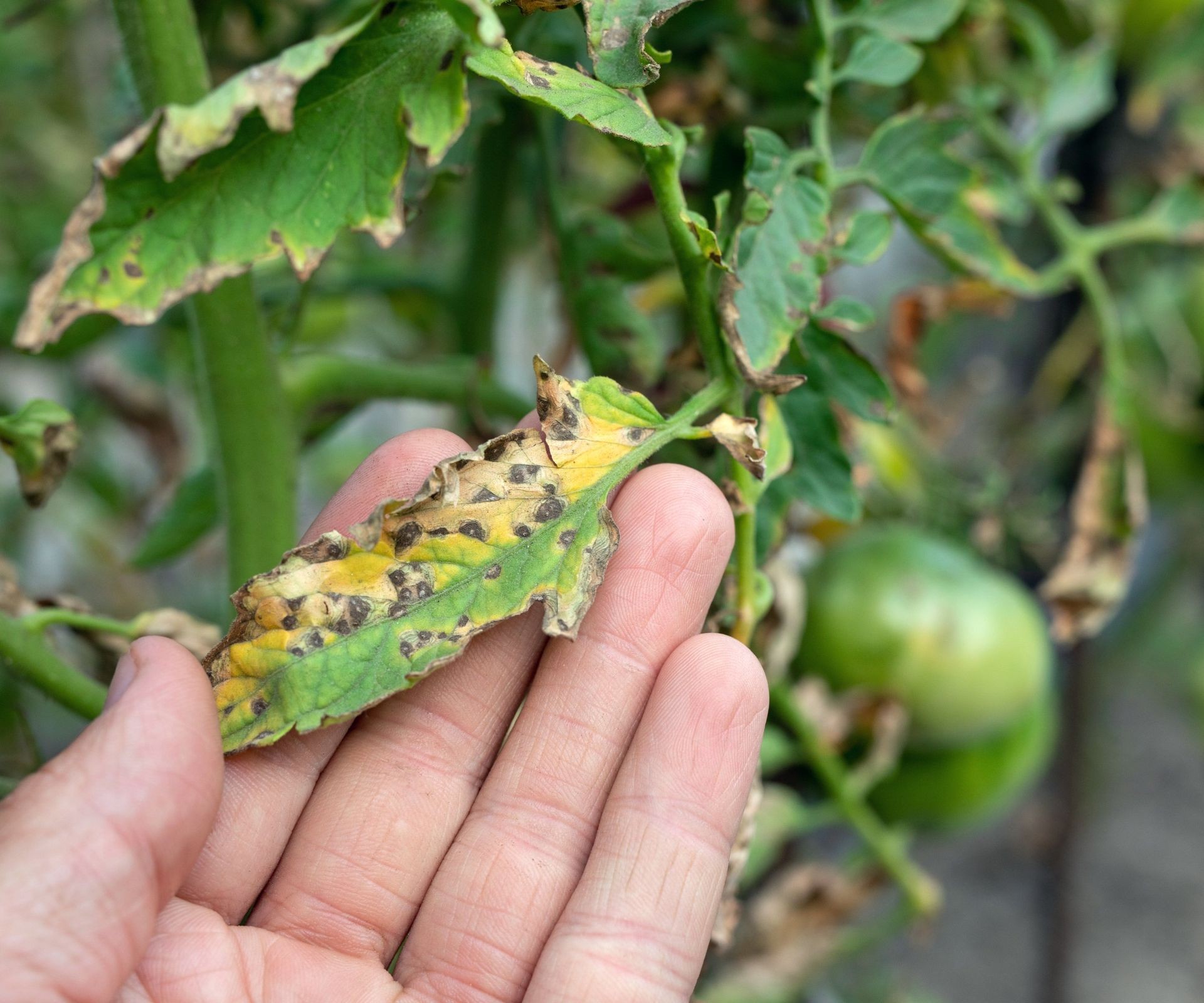 A hand holding a tomato leaf infected with septoria leaf spot
A hand holding a tomato leaf infected with septoria leaf spot